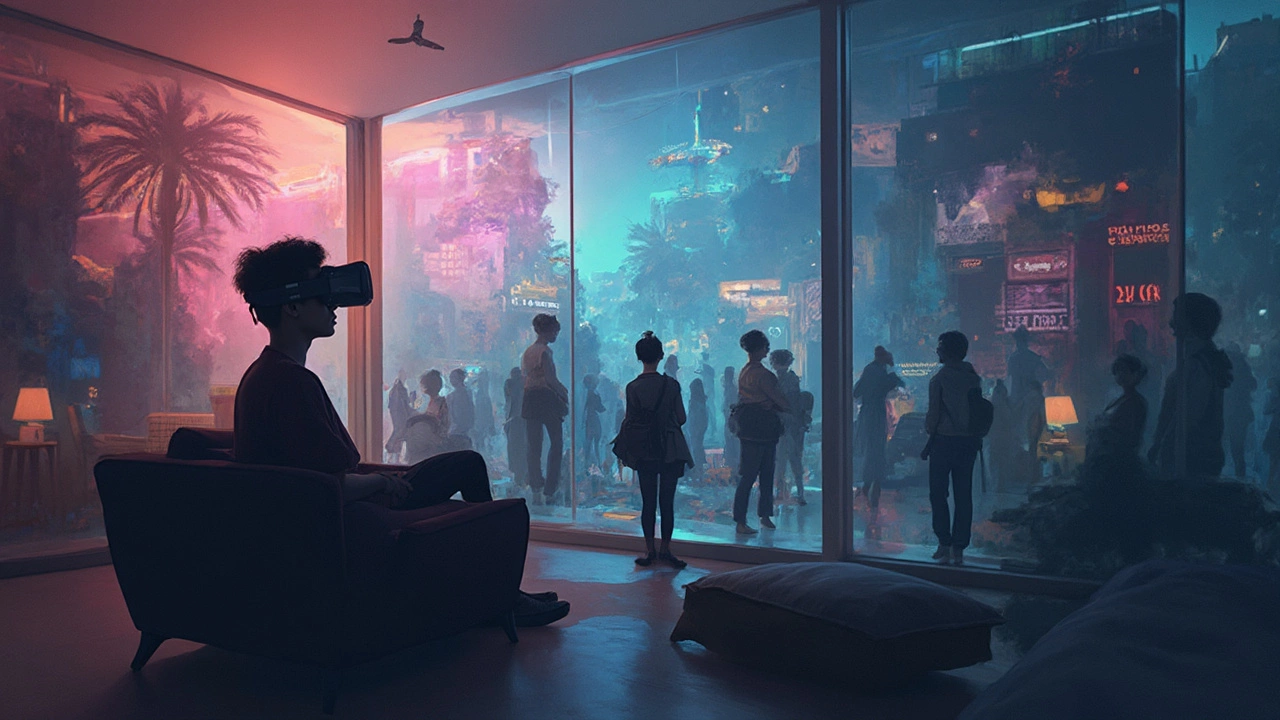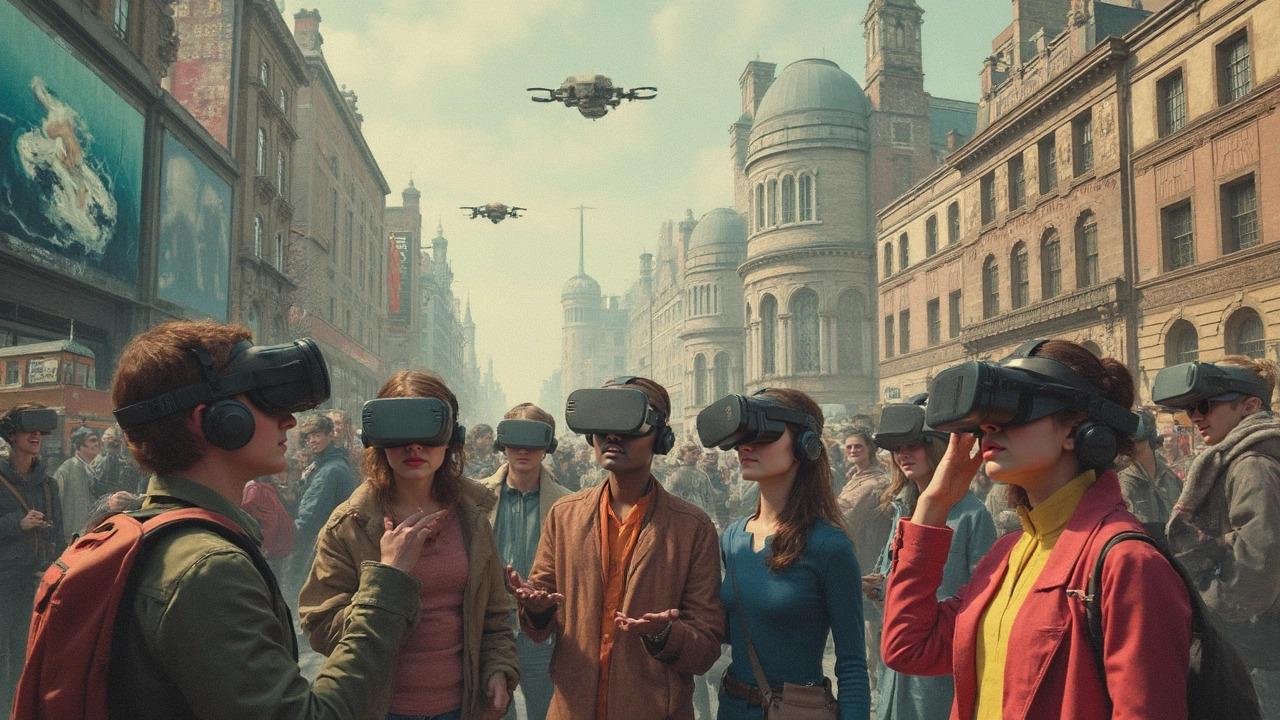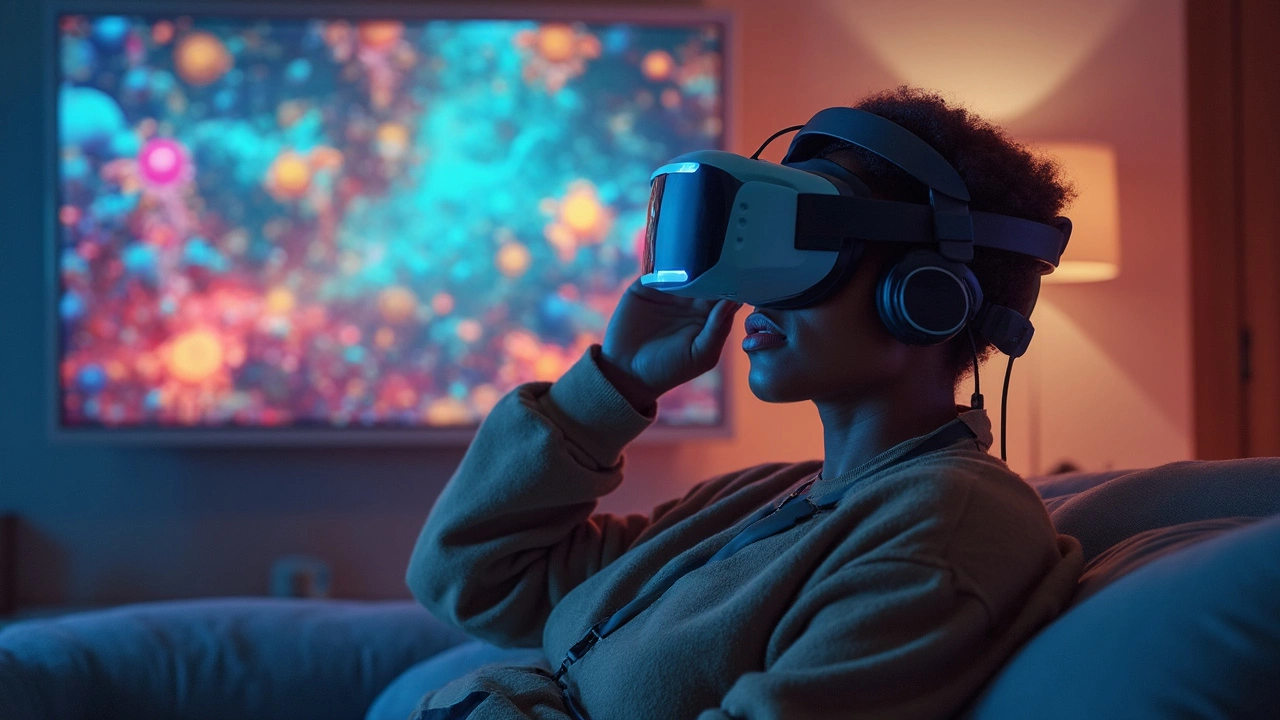Virtual reality is like stepping into another world, and it’s seriously cool. But have you ever thought about what could go wrong? Let's get real about some of the challenges VR brings along with its virtual magic.
First on the list is the physical side of things. Ever worn a VR headset for too long and felt dizzy or even a bit sick? You’re not alone. The way VR tricks our brains with visual inputs can mess with our inner ears, leading to what some call 'VR sickness.' Just like a bad amusement park ride, but without the fun pictures.
Another thing to consider is how VR might just be turning us into screen zombies. No joke! Spending too much time in these virtual spaces can make you forget there’s a whole real-world out there with friends and social ties. Plus, spending hours with a headset can seriously strain your eyes. We all know how much our parents nagged us about TV in the past—VR is the new target.
- Physical Discomfort and Health Risks
- Impact on Social Connections
- Addiction and Time Consumption
- VR and Real-world Integration Challenges
- Tips for a Balanced VR Experience
Physical Discomfort and Health Risks
Let’s be honest, wearing a VR headset can sometimes feel like you've strapped a small TV to your face, and it's not always the comfiest experience. One of the first things users notice is that these devices can be kind of bulky and heavy, which may lead to neck strain and even headaches after prolonged use.
There's also something called 'VR sickness,' which is similar to motion sickness. It happens when your brain gets mixed signals about movement—your eyes see action but your body doesn't feel it. This mismatch can cause nausea, dizziness, and even eye strain as your body tries to keep up with the virtual environment.
Eye Strain and Fatigue
It's not just about neck pains. Staring at screens close to your eyes for long periods can lead to digital eye strain. Ever notice that icky feeling after a marathon gaming session? Your eyes may feel tired or dry. The blue light from screens can also contribute, messing with your natural body clock and impacting sleep.
Physical Safety Concerns
Another biggie is safety while you're in the VR world. Tripping over cables, bumping into furniture, or even wall-running when too involved can happen more often than you think. It’s like sleepwalking but in a vivid dream-like experience!
Preventing Discomfort
- Take regular breaks. The 20-20-20 rule isn't just for regular screen time; every 20 minutes, look at something 20 feet away for 20 seconds.
- Make sure your play area is clear of obstacles to avoid accidents.
- Adjust the headset correctly every time you use it to minimize pressure.
- Consider investing in an ergonomic chair or pillow if you plan on long sessions.
While virtual reality offers amazing experiences, staying informed about these potential setbacks can help you enjoy it without the downsides. So, strap carefully and use responsibly!
Impact on Social Connections
Virtual reality is like a double-edged sword when it comes to social connections. It offers some fantastic opportunities to connect with others globally, but it can also pull us away from real-world interactions. Let’s break down how this balance plays out.
The Upside
Sure, VR can be a social connector. People can meet in virtual spaces, play games, attend virtual events, and even host business meetings from their living rooms. For folks who are geographically isolated or have mobility issues, this is a game-changer. We're not just typing messages on a screen—it's like we're hanging out in the same space, no matter the distance.
The Downside
But here’s the catch. Spending too much time in these virtual worlds can isolate users from the physical world, leading to a reduction in face-to-face interactions. Imagine how easy it is to get lost in your VR environment and neglect the people right next to you. The senses are engaged elsewhere, while your real-life relationships might suffer.
Social Isolation Risks
Recent studies show that heavy use of VR can contribute to feelings of loneliness and depression. It’s because while you are 'virtually' social, you might avoid cultivating meaningful relationships. Think of it this way: having VR friends doesn't replace the laughter, warmth, and presence of hanging out with people in real life.
Striking a Balance
It’s all about balance. Use VR to enhance your social life but not replace it completely. Maybe set a time limit for your VR sessions or make a rule to follow up a virtual meet-up with a real call or visit. Keep nurturing those face-to-face friendships!
VR limitations aside, being mindful of how it affects our social interactions is crucial, and taking steps to balance it can help maintain healthy relationships.

Addiction and Time Consumption
Alright, let’s talk about something a bit worrisome—how virtual reality can become a bit too engrossing. It's no secret that VR is incredibly immersive; it’s like your brain forgets the real world exists when you’re adventuring in these amazing digital landscapes. But here's the catch: this can lead to addiction. Seriously, getting lost in VR is easier than you’d think. Before you know it, you've spent an entire day inside a headset.
Why does this happen? Well, VR taps into our senses and emotions in a way regular gaming or binge-watching just doesn't. The immersive design can create what feels like an alternate life, so it’s not hard to see why some fall into the trap of wanting to stay there longer and longer. Studies have pointed out that the more fulfilling these virtual experiences feel, the more likely users are to prioritize them over real-world interactions.
Balancing VR with Real Life
Finding a balance is key to enjoying virtual reality without falling into the trap of overuse. Here are some tips:
- Set Time Limits: Just like you’d limit screen time for kids, do it for yourself with VR. Decide beforehand how much time you’ll spend in VR and stick to it.
- Mix it Up: Make sure you’re also engaging with the physical world. Meet friends, exercise, or catch up on hobbies that don’t involve a headset.
- Take Breaks: When using VR for longer sessions, take regular breaks to give your eyes and mind a rest. Step outside, stretch, and drink some water.
These strategies can help maintain a healthy relationship with virtual reality without letting it consume all your time.
Understanding the Risks
According to experts, excessive use of VR can sometimes have negative effects, similar to gaming addiction. Social isolation is a common risk; the more time you spend in VR, the less you interact with others in the real world. And let’s face it, nothing beats a real-life coffee with a friend.
Turning too much attention to VR can also lead to neglecting daily responsibilities like work, studies, or even sleeping habits. Keep an eye out for these signs so you can nip any growing dependency in the bud.
VR and Real-world Integration Challenges
Getting VR to fit into our everyday lives isn't as easy as it sounds. There’s a lot to consider when trying to blend virtual reality with the real world.
Accessibility and Cost
Let’s face it, virtual reality gear isn’t cheap. A good setup can set you back a chunk of change, which means not everyone can jump on the VR bandwagon. And if affordability wasn’t enough, there’s the whole hassle of setting up. You need ample space, the right tech, and sometimes even a top-notch internet connection to get the best experience. So, yes, accessibility is a big hurdle.
Workplace Balancing Act
While there's plenty of buzz about remote work possibilities and VR's potential to replace traditional offices, the practical side of things is still lagging behind. Not all jobs are VR-friendly. Also, it’s tricky to create virtual environments that match the dynamics of face-to-face meetings. Elizabeth Thompson, an expert in digital workplace solutions, points out,
"While VR offers exciting prospects, businesses need tools that integrate seamlessly with existing workflows, and currently, VR isn’t quite there yet."
Cultural and Ethical Considerations
There’s more to think about than just gadgets and gear—there are social issues too. How do we make sure VR’s impact is positive and inclusive? Not everyone experiences VR the same way. Cultural differences can affect how technology is used and accepted in different countries. Plus, ethical concerns like privacy and virtual content moderation are still hot topics.
With all these challenges, integrating VR effectively into everyday scenarios is still somewhat of a balancing act. It's a work in progress—requiring innovation, cooperation, and sometimes, patience. But no doubt, it's an exciting area to watch as it evolves.

Tips for a Balanced VR Experience
Diving into virtual reality is thrilling, but keeping things balanced is key to enjoying it without the downsides. Whether you're a casual gamer or a VR enthusiast, these tips will help you find that sweet spot between fun and overkill.
Limit Your Time
Start by setting time limits. Experts suggest 20 to 30 minutes per session to avoid neck strain or eye strain. If you feel dizzy or slightly off, take a break. It’s better to play in bursts than overstay your welcome in the virtual world.
Comfortable Setup
Make sure your play area is comfortable and safe. Clear the floor of obstacles, ensuring you have plenty of room to move around without tripping over cables or stepping on the cat. This avoids any physical discomfort or potentially dangerous accidents.
Take Regular Breaks
Just like with any screen time, give your eyes a rest. Use the 20-20-20 rule: every 20 minutes, look at something 20 feet away for at least 20 seconds. This simple practice can help reduce eye strain.
Mind the Content
Pay attention to the type of content you're engaging with. Some VR games are intense and can affect your mood. Balance your sessions with relaxed content and consider VR experiences that encourage physical activity or mindfulness to boost your well-being.
Socialize and Share
While VR can feel like a solo endeavor, sharing your experiences with real-world friends is a game-changer. Talk about the cool stuff you’ve seen or invite a friend to join in and try out multiplayer experiences. This keeps your social connections strong and encourages more real-world interaction.
By mixing these tips into your VR routine, you’ll be able to enjoy those jaw-dropping experiences without any of the negatives overshadowing your fun. Keep it balanced, and VR will stay awesome!

